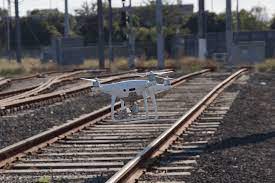The use of drones has increased significantly in recent years, and industries have been quick to adopt them as a tool for inspection. Drones can provide a safe and efficient means of inspecting various structures, including buildings, bridges, power lines, wind turbines, and more. In this article, However, with the benefits come to some drawbacks, and it is important to consider both when deciding whether to use drones for inspections.
Benefits of Drone-Based Inspections
One of the most significant benefits of using drones for inspections is safety. Inspecting structures such as roofs, towers, or bridges can be dangerous, requiring workers to climb up to great heights or work in confined spaces. Drones can eliminate this danger by conducting inspections from a safe distance. With a drone, inspections can be done remotely, reducing the need for workers to be physically present in potentially hazardous locations.

Efficiency is another significant benefit of using drones for inspections. Drones can complete inspections quickly and with greater accuracy than traditional inspection methods. With a drone, inspections can be completed in a fraction of the time it would take for a human inspector to complete them. The data collected by drones is also highly accurate, allowing for more informed decisions to be made.
Drones can also access areas that are difficult or impossible to reach with traditional inspection methods. For example, drones can inspect the tops of wind turbines or power lines, which can be difficult for human inspectors to reach safely. Drones can also access areas that are dangerous for human inspectors to access, such as the interior of nuclear reactors or pipelines.
Drawbacks of Drone-Based Inspections. While there are many benefits to using drones for inspections, there are also some drawbacks that need to be considered.
One of the main drawbacks of using drones for inspections is their cost. Drones can be expensive to purchase and maintain, and they require skilled operators to operate them. This can add to the overall cost of inspections, making them less attractive to some industries.
Another potential drawback is the limited battery life of drones. Depending on the type of drone being used, battery life can range from 20 to 30 minutes. This means that inspections may need to be completed on multiple flights, which can add to the overall time and cost of inspections.
Weather can also be a limiting factor for drone-based inspections. Drones are not able to fly in all weather conditions, and high winds or rain can make it impossible for drones to safely operate. This means that inspections may need to be rescheduled, which can be inconvenient and add to the overall cost of inspections.
Finally, there are privacy and regulatory concerns to consider when using drones for inspections. Drones can capture images and video footage of private property or people without their consent, which can lead to legal issues. Regulations around drone use are also constantly evolving, and it is important to stay up-to-date with the latest regulations to ensure compliance.
Applications of Drone-Based Inspections in Various Industries Drones can be used for inspections in a wide range of industries.
Some of the most common industries that use drone-based inspections include:
- Construction– Drones can be used to inspect building sites and structures, including bridges and highways, for safety and compliance purposes.
- Energy- Drones can be used to inspect power lines, wind turbines, and oil and gas infrastructure for maintenance and safety purposes.
- Agriculture- Drones can be used to inspect crops for damage, disease, or pests, and can also be used to monitor irrigation systems.
- Insurance- Drones can be used to assess damage to buildings and other structures for insurance purposes, reducing the need for human inspectors to visit sites in person.
- Media- Drones can be used to capture images and video footage for news and entertainment purposes, providing a unique perspective that would be difficult or impossible to capture with traditional filming methods.
- Environmental monitoring- Drones can be used to monitor and assess environmental conditions in areas that are difficult or dangerous for humans to access, such as areas affected by natural disasters or industrial accidents.
- Mining- Drones can be used to inspect mine sites for safety and compliance purposes, as well as to survey and map mining sites.
- Transportation- Drones can be used to inspect transportation infrastructure, such as bridges and tunnels, for safety and maintenance purposes.
Overall, the use of drones for inspections has many potential benefits, including increased safety, efficiency, and access to difficult-to-reach areas. However, there are also some drawbacks to consider, such as cost, battery life, weather limitations, and regulatory concerns.

As the technology continues to improve and become more widely available, we will likely see more industries adopting drone-based inspections as a regular part of their operations. However, it is important to carefully consider the benefits and drawbacks before deciding whether to use drones for inspections and to stay up-to-date with the latest regulations and best practices for drone use.
Best Practices for Drone-Based Inspections
If you are considering using drones for inspections, there are several best practices that you should follow to ensure that you are using them safely and effectively.
- Hire a skilled operator: Drones require skilled operators to operate them safely and effectively. Make sure to hire an operator who is properly trained and licensed to operate a drone.
- Conduct a pre-flight inspection: Before each flight, inspect the drone to ensure that it is in good working condition and that all equipment is properly attached and functioning.
- Check weather conditions: Drones cannot safely operate in all weather conditions, so be sure to check weather conditions before each flight to ensure that it is safe to fly.
- Respect privacy: Drones can capture images and video footage of private property or people without their consent, so be sure to respect privacy and follow all relevant privacy laws and regulations.
- Keep records: Keep a record of all drone flights, including the date, time, location, and purpose of the flight, as well as any data collected during the flight.
- Stay up-to-date on regulations: Regulations around drone use are constantly evolving, so be sure to stay up-to-date with the latest regulations to ensure compliance.
Conclusion
Drones have the potential to revolutionize inspections in a wide range of industries, providing a safe, efficient, and effective means of inspecting structures and collecting data. However, it is important to carefully consider the benefits and drawbacks before deciding whether to use drones for inspections and to follow best practices to ensure that they are used safely and effectively. With the right equipment, training, and regulatory compliance, drone-based inspections can provide a significant boost to efficiency and safety in various industries.









